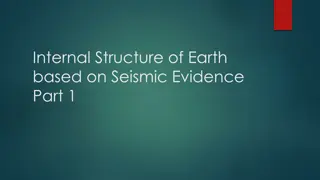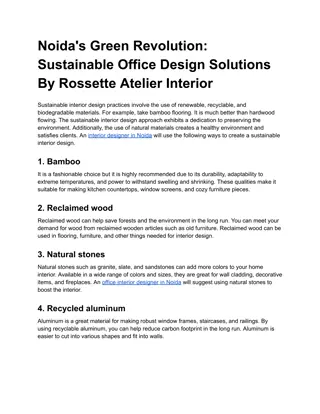Interior of the Earth
Explore the mysteries of Earth's interior, from the crust to the core, delving into the origin of the planet and the concept of continental drift. Discover the fascinating theories and scientific evidence that shape our understanding of the inner layers of our cosmic home.
Download Presentation

Please find below an Image/Link to download the presentation.
The content on the website is provided AS IS for your information and personal use only. It may not be sold, licensed, or shared on other websites without obtaining consent from the author.If you encounter any issues during the download, it is possible that the publisher has removed the file from their server.
You are allowed to download the files provided on this website for personal or commercial use, subject to the condition that they are used lawfully. All files are the property of their respective owners.
The content on the website is provided AS IS for your information and personal use only. It may not be sold, licensed, or shared on other websites without obtaining consent from the author.
E N D
Presentation Transcript
synopsis 6 crust Introduction 1 7 mantle 2 Origin of the Earth 3 Continental Drift 8 Outercore Innercore 4 Atmosphere 9 5 Interior of the Earth conclusion 10
Introduction 1 Our Earth is a cosmic Body. It is an insignificant speck of Dust in the Universe though the universe itself is a vast infinite expanse of space and matter. The planets in the order of increasing distance from the Sun are Mercury, Venus, Earth, Mars, Jupiter, Saturn, Uranus, Neptune and Pluto On their basis of their of location the planets are divided into, Inner Planets: Mercury, Venus, Earth, Mars Outer planets: Jupiter, Saturn, Uranus, Neptune and Pluto
2 Origin of theEarth In general the theories of the origin of the solar system can be divided into: 1. Evolutionary theories 2. Catastrophic theories EvolutionaryTheories: The theories which implies that the planets are formed during the evolution of the sun are Ex: Nebular hypothesis Catastrophic theories: It implies that the planets are formed by some special accident, Such as the close approach of two stars or by collision of two stars Ex: planetesial hypothesis, Gaseous tidal hypothesis, binary star hypothesis, Gas dust cloud hypothesis
Origin of the Earth 2 Nebular Hypothesis
2 Origin of the Earth Planetesimal Hypothesis
2 Origin of the Earth Binary Star Hypothesis
3 Continental Drift Continental drift was a theory that explained how continents shift position on Earth's surface. In 1912 Alfred Wegener, a geophysicist and meteorologist, Continental drift was evidenced by animal and plant fossils, and similar rock formations, are found on different continents The solid continental masses of the Earth s crust are assumed to be moving over the underlying viscous Fluid in the mantle, The action of drift from one place to another place under the influence of force such as Tidal force He originated this theory because of the east coast of South America fits into the west coast of Africa Due to his assumption the super continent consisting of North America, Europe, Asia, South America, Africa, Antarctica, India and Australia So the supercontinent was termed as Pangaea The water bodies are termed as Panthalasa
3 Continental Drift
4 Atmosphere
Interior of theEarth 5 Man has actually looked into the earth in deep mines and drill holes only a very small distance about 5 miles of the 4,000-mile distance to the earth's center. Furthermore, man will likely never be able to make a hole into the deep interior, At present, this evidence consists of (1) Direct observation of rocks at the surface, (2)Secondary observations based on geophysical phenomena (including waves through the earth from earthquakes and explosive sources, planetary motions of the earth, flow of heat from the interior, the magnetic field, and gravitational attraction), (3) Laboratory experiments on surface rocks and minerals, (4) Comparison of the earth with the other planets, the sun, stars, and meteorites,
Interior of theEarth 5 The study of the passage of seismic waves through the earth have helped in knowing the earth interior defining the physical properties of the earth The seismic waves travels at different velocities depending upon the nature of the layer of the earth Simultaneously the seismic waves helps to locate the composition of the layer Based on those evidences the earth is divided into 4 major layers
crust 6 Crust is the outer most part of the Earth It extends up to 70-80km Earthquake waves transmitted through the earth are of twotypes: (1) compressional waves, P , in which motion of solid particles is back and forth, parallel to the direction of travel, (2) Shear waves, S, in which particle motion is across, transverse to the direction oftravel. The velocity of the earthquake waves increases abruptly as they enter into the denser layer calledmantle Andrija Mohorovicic first noted and this boundary is now referred to as the Mohorovicic discontinuity in 1909 which acts as a crust-mantleboundary crust is divided into Continental crust and OceanicCrust .
6 crust Continentalcrust: The continental crust is largely made up of dense light-colored igneous rocks, such as granite or quartz diorite, in the upper part and basalt, a dark and slightly denser igneous rock (commonly erupted from volcanoes) which is in the composition of (silica +alumina) Sial. Oceanic Crust: The oceanic crust appears to be composed almost entirely of basalt. which is in the composition of (silica + magnesium) sima.
6 crust Conrad discontinuity: The Conrad discontinuity is considered to be the border between the upper continental crust and the lower upper continental crust It is not as pronounced as the Mohorovicic discontinuity the seismologists considered that the Conrad discontinuity should correspond to a sharply defined contact between the chemically distinct two layers, sial and sima The underground diamond mines of South Africa and Siberia do not extend to as great a depth as the gold mines, but the diamond "pipes" themselves in which the mining is done, extend as tubular conduits (hence the name "pipe") deep into the earth It was termed as a second order discontinuity
6 crust Lithosphere: The concept of the lithosphere as Earth s strong outer layer was described by A.E.H. Love in 1911 Earth's lithosphere includes the crust and the uppermost mantle, which constitute the hard and rigid outer layer of the Earth. The lithosphere is subdivided into tectonic plates. The uppermost part of the lithosphere that chemically reacts to the atmosphere, hydrosphere and biosphere through the soil forming process is called the Pedosphere The lithosphere is underlain by the asthenosphere which is the weaker, hotter, and deeper part of the upper mantle. There are two types of lithosphere: Oceanic lithosphere, which is associated with oceanic crust and 50 140 km thick Continental lithosphere, which is associated with continental crust and 40 to 280 km thick
crust 6 Lithosphere:
mantle 7 Mantle is located beneath the earth crust and it has a thickness of about 2888Km Mantle covers a 83% of the earth s volume It is divided into two layers :1)upper mantle 2)lower mantle Earthquake wave velocities are faster in the upper mantle than in the crust It provide a source for the lava erupted from volcanoes or extruded in diamond pipes. The composition of the mantle has been studied from volcanic lava, diamond pipes, and meteorites and from experiments on minerals and rocks. These studies indicate that the upper few hundred miles may be composed of eclogite and peridotite, which are composed mostly of iron and magnesium silicate minerals and some complex calcium, sodium, and aluminum silicate minerals. In the lower mantle, because of the very high pressure, only the simple oxides of iron, magnesium, and silicon are thought to be present. The upper mantle is divided into:1) Asthenosphere 2)Transition zone
mantle 7
7 mantle Asthenosphere: The asthenosphere is the highly viscous, mechanically weak and ductilely deforming region of the upper mantle of the Earth. It lies below the lithosphere, at depths between approximately 80 and 200 km (50 and 120 miles) below the surface The asthenosphere is a part of the upper mantle just below the lithosphere that is involved in plate tectonic movement and isostatic adjustments. Seismic waves pass relatively slowly through the asthenosphere compared to the overlying lithospheric mantle, thus it has been called the low-velocity zone (LVZ)
7 mantle Transition zone: The transition zone is part of the Earth s mantle, and is located at the upper mantle, between a depth of 410 and 660 km The Earth s mantle, including the transition zone, consists primarily of peridotite, an ultramafic igneous rock. The mantle was divided into the upper mantle, transition zone, and lower mantle as a result of sudden Seismic velocity discontinuities at depths of 410 and 660 km This is thought to occur as a result of rearrangement of grains in olivine (which constitutes a large portion of peridotite) at a depth of 410 km Below a depth of 660 km, evidence suggests due to pressure changes ringwoodite minerals change into two new denser phases, bridgmanite and periclase.
8 Outer core Below the mantle is the earth's core, discovered by R. D. Oldham in 1906 from a study of earthquake records.The core itself is divided into and outer part and an inner part core is presumed to be liquid because it does not transmit shear waves (S), and because it sharply reduces the velocity of compressional waves (P). The ray paths of earthquake waves from the focus, where the fault displacement or other disturbanceinitiates the Earthquake are curved in passing through the earth; the curvature is a refraction due to the increase in Velocity with depth. The outer core was discovered when it was found that P-waves were bent inwards producing a shadowzone Outer core is composed mainly of Iron andnickel Eddy currents in the nickel iron fluid of the outer core are believed to influence the Earth's magnetic field The average magnetic field strength in the Earth's outer core was measured to be 2.5 millitesla, 50 times stronger than the magnetic field at thesurface The boundary of the Earth between the core mantle was termed as Guttenberg discontinuity. Thisboundary located at approximately 2891 km depth beneath the Earth'ssurface
8 Outer core By analyzing seismograms for the variation of P and S wave velocities with depth earth's average density (5.5 g per cm3 ), the density of the core has been determined to be about (11 g percm3) Iron is the most likely constituent ofthe core for the following reasons: Iron has aboutthe right density; its abundance in the earth would be about the same as in the sun andstars; it occurs in large proportions in meteorites,
8 Outer core At the outer boundary of the core, there is a sharp discontinuity in both the P-wave velocity and the density, These very striking changes in properties occur in a narrow border zone between the mantle and core, perhaps less than 10 miles thick. It is certain that there is a marked compositional difference between the Mantle and core.
Innercore 9 The Earth was discovered to have a solid inner core distinct from its molten outer core in 1936, by the Danish seismologist Inge Lehmann The Inner core may extends from 5100km to 6371km to the earth center. It transmits P-waves at a higher velocity which indicates that it is in the solidstate Both solid and liquid proportions of the core are believed to consist of iron and nickel similar to iron meteorites The temperature at the inner core's surface is approximately 5,700K (5426.85) C The boundary between the outer and inner core is known as the Bullen discontinuity, or sometimes as the Lehmann discontinuity
Comparison of the earth with the other planets, the sun, stars, and meteorites, 10 Recent data from American and Soviet satellites show that the moon's magnetic field is verysmall, which indicates that there is only a smallamount of iron in the moon; furthermore, the iron isprobably dispersed and not in a centralcore,
Physical and Engineering Geology-S.K.Garg( pg no:7-20) Principles of Enginneering Geology-K.M.Bangar(Pg.no:3-30) Engineering and General Geology Parbin singh(pg no:18-34) Geological survey report interior of the Earth By Eugene C. Robertson(Pg.no:1-10) ZANG Shao-xian, et al: STRUCTURE AND PHYSICAL PROPERTIES OF EARTH S INTERIOR ACTA SEISMOLOGICA SINICA Vol.16 No.5(522~533)































